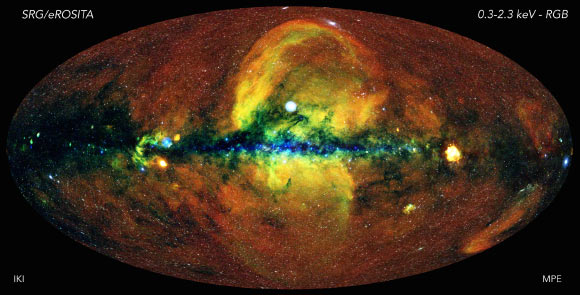A new all-sky image from the eROSITA X-ray telescope onboard the Spectrum-Roentgen-Gamma (SRG) space observatory contains over one million objects, about half of which are new to astronomers.
Source: Sci News
“This all-sky image completely changes the way we look at the energetic Universe,” said eROSITA principal investigator Dr. Peter Predehl, an astronomer at the Max Planck Institute for Extraterrestrial Physics.
“We see such a wealth of detail – the beauty of the images is really stunning.”
Most of the objects in the eROSITA all-sky image are active galactic nuclei and huge clusters of galaxies.
It shows the structure of hot gas in the Milky Way itself, and the circumgalactic medium, whose properties are key to understanding the formation history of our Galaxy.
It also reveals stars with strong, magnetically active hot coronae; binary stars containing neutron stars, black holes or white dwarfs; and spectacular supernova remnants in our own and other nearby galaxies such as the Magellanic Clouds.
An annotated version of the eROSITA all-sky image. Several prominent X-ray features are marked, ranging from distant galaxy clusters (Coma, Virgo, Fornax, Perseus) to extended sources such as supernova remnants (SNRs) and nebulae to bright point sources, e.g. Sco X-1, the first extrasolar X-ray source to be detected. The Vela SNR is to the right of this image, the Large Magellanic Cloud in the bottom right quadrant, the Shapley Supercluster in the upper right. Image credit: Jeremy Sanders, Hermann Brunner & the eSASS team / Max Planck Institute for Extraterrestrial Physics / Eugene Churazov & Marat Gilfanov, IKI.
“We were all eagerly awaiting the first all-sky map from eROSITA,” said Dr. Mara Salvato, also from the Max Planck Institute for Extraterrestrial Physics.
“Large sky areas have already been covered at many other wavelengths, and now we have the X-ray data to match.”
“We need these other surveys to identify the X-ray sources and understand their nature.”
The eROSITA image also shows rare and exotic phenomena, including numerous types of transients and variables, such as flares from compact objects, merging neutron stars, and stars being swallowed by black holes.
“eROSITA often sees unexpected bursts of X-rays from the sky,” Dr. Salvato said.
“We need to alert ground-based telescopes immediately to understand what’s producing them.”
Source: Sci News

































Leave a Comment
You must be logged in to post a comment.